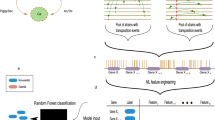Abstract
Transposon-based mutagenesis is an effective method for genetic screening on a genome-wide scale, with particular applicability in organisms possessing compact genomes where transforming DNA tends to integrate by homologous recombination. Methods for transposon mutagenesis have been applied with great success in the budding yeast Saccharomyces cerevisiae and in the related pathogenic yeast Candida albicans. In C. albicans, we have implemented transposon mutagenesis to generate heterozygous mutations for the analysis of complex haploinsufficiency, a type of synthetic genetic interaction wherein a pair of non-complementing heterozygous mutations results in a stronger phenotype then either individual mutation in isolation. Genes exhibiting complex haploinsufficiency typically function within a regulatory pathway, in parallel pathways, or in parallel branches within a single pathway. Here, we present protocols to implement transposon mutagenesis for complex haploinsufficiency screening in C. albicans, indicating methods for transposon construction, mutagenesis, phenotypic screening, and identification of insertion sites in strains of interest. In total, the approach is a useful means to implement large-scale synthetic genetic screening in the diploid C. albicans.
Access this chapter
Tax calculation will be finalised at checkout
Purchases are for personal use only
Similar content being viewed by others
References
Lo HJ, Kohler JR, DiDomenico B, Loebenberg D, Cacciapuoti A, Fink GR (1997) Nonfilamentous C. albicans mutants are avirulent. Cell 90:939–949
Saville SP, Lazzell AL, Monteagudo C, Lopez-Ribot JL (2003) Engineered control of cell morphology in vivo reveals distinct roles for yeast and filamentous forms of Candida albicans during infection. Eukaryot Cell 2:1053–1060
Noble SM, French S, Kohn LA, Chen V, Johnson AD (2010) Systematic screens of a Candida albicans homozygous deletion library decouple morphogenetic switching and pathogenicity. Nat Genet 42:590–598
Homann OR, Dea J, Noble SM, Johnson AD (2009) A phenotypic profile of the Candida albicans regulatory network. PLoS Genet 5:e1000783
Blankenship JR, Fanning S, Hamaker JJ, Mitchell AP (2010) An extensive circuitry for cell wall regulation in Candida albicans. PLoS Pathog 6:e1000752
Uhl MA, Biery M, Craig N, Johnson AD (2003) Haploinsufficiency-based large-scale forward genetic analysis of filamentous growth in the diploid human fungal pathogen C.albicans. EMBO J 22:2668–2678
Tong AH, Evangelista M, Parsons AB, Xu H, Bader GD, Page N et al (2001) Systematic genetic analysis with ordered arrays of yeast deletion mutants. Science 294:808–813
Tong AH, Boone C (2006) Synthetic genetic array analysis in Saccharomyces cerevisiae. Methods Mol Biol 313:171–192
Winzeler EA, Shoemaker DD, Astromoff A, Liang H, Anderson K, Andre B et al (1999) Functional characterization of the S. cerevisiae genome by gene deletion and parallel analysis. Science 285:901–906
Stearns T, Botstein D (1988) Unlinked noncomplementation: isolation of new conditional lethal mutations in each of the tubulin genes of Saccharomyces cerevisiae. Genetics 119:249–260
Reuter G, Wolff I (1981) Isolation of dominant suppressor mutations for position-effect variegation in Drosophila melanogaster. Mol Gen Genet 182:516–519
Haarer B, Viggiano S, Hibbs MA, Troyanskaya OG, Amberg DC (2007) Modeling complex genetic interactions in a simple eukaryotic genome: actin displays a rich spectrum of complex haploinsufficiencies. Genes Dev 21:148–159
Bharucha N, Chabrier-Rosello Y, Xu T, Johnson C, Sobczynski S, Song Q et al (2011) A large-scale complex haploinsufficiency-based genetic interaction screen in Candida albicans: analysis of the RAM network during morphogenesis. PLoS Genet 7:e1002058
McNemar MD, Fonzi WA (2002) Conserved serine/threonine kinase encoded by CBK1 regulates expression of several hypha-associated transcripts and genes encoding cell wall proteins in Candida albicans. J Bacteriol 184:2058–2061
Saputo S, Chabrier-Rosello Y, Luca FC, Kumar A, Krysan DJ (2012) The RAM network in pathogenic fungi. Eukaryot Cell 11:708–717
Song Y, Cheon SA, Lee KE, Lee SY, Lee BK, Oh DB et al (2008) Role of the RAM network in cell polarity and hyphal morphogenesis in Candida albicans. Mol Biol Cell 19:5456–5477
Burns N, Grimwade B, Ross-Macdonald PB, Choi E-Y, Finberg K, Roeder GS et al (1994) Large-scale characterization of gene expression, protein localization and gene disruption in Saccharomyces cerevisiae. Genes Dev 8:1087–1105
Ross-Macdonald P, Coelho PS, Roemer T, Agarwal S, Kumar A, Jansen R et al (1999) Large-scale analysis of the yeast genome by transposon tagging and gene disruption. Nature 402:413–418
Kumar A, Seringhaus M, Biery MC, Sarnovsky RJ, Umansky L, Piccirillo S et al (2004) Large-scale mutagenesis of the yeast genome using a Tn7-derived multipurpose transposon. Genome Res 14:1975–1986
Biery MC, Stewart FJ, Stellwagen AE, Raleigh EA, Craig NL (2000) A simple in vitro Tn7-based transposition system with low target site selectivity for genome and gene analysis. Nucleic Acids Res 28:1067–1077
Ma J, Dobry CJ, Krysan DJ, Kumar A (2008) Unconventional genomic architecture in the budding yeast Saccharomyces cerevisiae masks the nested antisense gene NAG1. Eukaryot Cell 7:1289–1298
Seringhaus M, Kumar A, Hartigan J, Snyder M, Gerstein M (2006) Genomic analysis of insertion behavior and target specificity of mini-Tn7 and Tn3 transposons in Saccharomyces cerevisiae. Nucleic Acids Res 34:e57
Stellwagen A, Craig N (1997) Gain-of- function mutations in TnsC, an ATP- dependent transposition protein that activates the bacterial transposon Tn7. Genetics 145:573–585
Bachman N, Biery MC, Boeke JD, Craig NL (2002) Tn7-mediated mutagenesis of Saccharomyces cerevisiae genomic DNA in vitro. Methods Enzymol 350:230–247
Stellwagen AE, Craig NL (1997) Avoiding self: two Tn7-encoded proteins mediate target immunity in Tn7 transposition. EMBO J 16:6823–6834
Davis DA, Bruno VM, Loza L, Filler SG, Mitchell AP (2002) Candida albicans Mds3p, a conserved regulator of pH responses and virulence identified through insertional mutagenesis. Genetics 162:1573–1581
Author information
Authors and Affiliations
Corresponding author
Editor information
Editors and Affiliations
Rights and permissions
Copyright information
© 2015 Springer Science+Business Media New York
About this protocol
Cite this protocol
Horton, B.N., Kumar, A. (2015). Genome-Wide Synthetic Genetic Screening by Transposon Mutagenesis in Candida albicans . In: Lu, L. (eds) Gene Essentiality. Methods in Molecular Biology, vol 1279. Humana Press, New York, NY. https://doi.org/10.1007/978-1-4939-2398-4_8
Download citation
DOI: https://doi.org/10.1007/978-1-4939-2398-4_8
Published:
Publisher Name: Humana Press, New York, NY
Print ISBN: 978-1-4939-2397-7
Online ISBN: 978-1-4939-2398-4
eBook Packages: Springer Protocols




